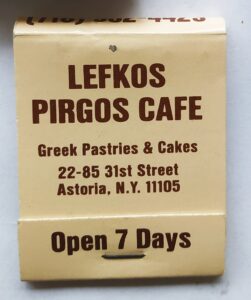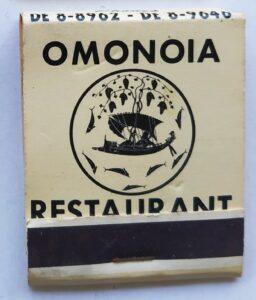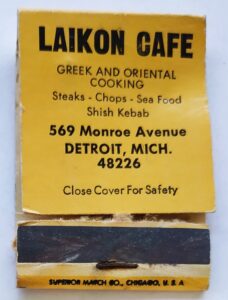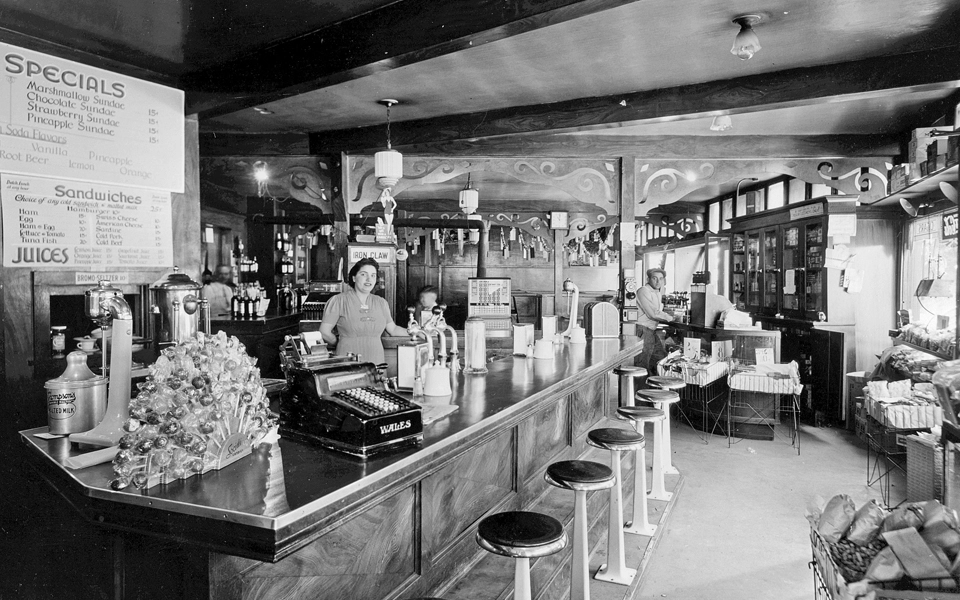



The collection of the “Museum of the Matchbox” has many matchboxes -more than 150- promotional of Greek restaurants in foreign countries. It is more than expected that many of them are from America and in fact from the 50s and 60s. Matchboxes from Greek restaurants, cafes and bars in Astoria, Detroit, Boston, Chicago and Florida.
 It is impossible to refer to the Greek diaspora, especially the one that took root in America, without recognizing the enormous importance played by the restaurant business – for the economic survival, social assimilation, advancement, development of our compatriots. Hundreds of thousands of Greeks lived the American dream in the kitchen of a restaurant, which they either owned or worked for.
It is impossible to refer to the Greek diaspora, especially the one that took root in America, without recognizing the enormous importance played by the restaurant business – for the economic survival, social assimilation, advancement, development of our compatriots. Hundreds of thousands of Greeks lived the American dream in the kitchen of a restaurant, which they either owned or worked for.
The identification of the Greek-American community with food was and still is absolute. In fact, he fed many jokes:
-What does a Greek do when he meets another Greek?
– Of course, they are opening a restaurant!
There were also a few racist and negative stereotypes:
“We have no Greeks and no rats”, wrote racistly the signs outside some San Francisco restaurants several decades ago.
But the fact was that the Greeks deservedly won a place in the sun, a place at the table of the “American family”, serving, cooking, washing dishes, often starting from scratch to quickly reach commercial success. With demons, stubbornness, hard work and the expectation of a better life for their children and grandchildren, they seized the opportunity and proved that they deserved a better fate than the impoverished compatriots who dragged carts of fruit and vegetables or worked in mining galleries.
Why did they choose the food services?
 Greek immigrants started working in restaurants for some basic reasons. The first emigrants to arrive, at the end of the great wave of migration from Southeastern Europe -from the 1870s to World War I- had no choice but to first start working as street vendors of food and fruit, jobs that were “surplus” and were in great demand in urban centers. From there, the move to restaurants was a normal development.
Greek immigrants started working in restaurants for some basic reasons. The first emigrants to arrive, at the end of the great wave of migration from Southeastern Europe -from the 1870s to World War I- had no choice but to first start working as street vendors of food and fruit, jobs that were “surplus” and were in great demand in urban centers. From there, the move to restaurants was a normal development.
The most important thing was that customer service required minimal knowledge of English and limited vocabulary set by the menu, while the preparation of food in the kitchen did not require special knowledge, language or techniques. Many Greeks came from small villages, where everyone knew and had an innate ability to cultivate interpersonal relationships with customers. They created a cordial, friendly atmosphere that was especially welcome to the solitary customers of the fast food restaurants (the so-called diners), who served workers and employees throughout the day.
They succeeded because it was a guarantee for the customers
Food services was the area in which the average American identified the Greek with positive connotations. After all, Greek property was a guarantee for customers and employees. In the middle of the 20th century there were about 35 to 40 thousand restaurants owned by Greece, a number much higher than the number of other businesses in Greek hands. So the next generations of Greeks remained in this field, but at the same time many children of restaurateurs managed to study and realize the American dream of social rise and progress.
 Meanwhile, the continued presence of Greeks in this area meant that, in addition to the now classic diners, restaurants with Greek cuisine in the style of taverns began to appear. In recent decades in major cities such as New York, there are restaurants of high quality gastronomy with Greek “teased” cuisine.
Meanwhile, the continued presence of Greeks in this area meant that, in addition to the now classic diners, restaurants with Greek cuisine in the style of taverns began to appear. In recent decades in major cities such as New York, there are restaurants of high quality gastronomy with Greek “teased” cuisine.
It is a wonderful journey that began a century ago with the first immigrant street vendors and that is a reflection of the assimilation and social rise of the Greeks – and their cuisine.


